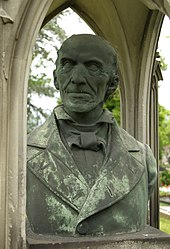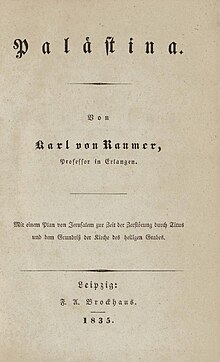Karl Georg von Raumer (geologist)
Karl Ludwig Georg von Raumer (born April 9, 1783 in Wörlitz , † June 2, 1865 in Erlangen ) was a German geologist , geographer and educator . The name of the Rhenish Slate Mountains goes back to him .
Life
Von Raumer was the son of the chamber director and domain tenant Georg Friedrich von Raumer (1755–1822) and Charlotte de Marées from Raguhn (1761–1811) and the brother of the historian Friedrich von Raumer . After attending the Joachimsthal Gymnasium, he first studied law and camera science at the universities of Göttingen and Halle an der Saale, but on the advice of Heinrich Steffens, after his exams, he also studied geognosy and mineralogy with Abraham Gottlob Werner at the Bergakademie Freiberg .
In 1810, through the mediation of his brother, Raumer was initially taken over as secretary at the Oberbergdepartement in Berlin , but only one year later he moved to the Oberbergamt in Breslau , where he was involved in important research projects with Carl Abraham Gerhard . At the same time he got a position as professor of mineralogy at the University of Wroclaw . Here he taught and researched until 1819, but took part in the occupation of Paris in the years 1813/14 as a war volunteer and adjutant under General August Neidhardt von Gneisenau as part of the wars of liberation . In 1812 the Bavarian Academy of Sciences appointed him a corresponding member.
Due to his support of the old Breslau fraternity of the Raczeks , he came into conflict with his superior and was transferred to the University of Halle and the local mining authority as a result of the Karlsbad resolutions .
But after he was attacked here as well, he said goodbye in 1823 and initially joined the Nuremberg educational institute of the reform pedagogue Heinrich Dittmar . Due to his commitment to a strictly religious education in the sense of pietism , which he could only enforce there with considerable difficulty, the school lost all students by 1826 and had to be closed in 1827. As a result, Raumer was appointed professor of natural history and mineralogy at the University of Erlangen , where he taught until the end of his life. Here, too, he quickly made contact with the theologians Christian Krafft , Wilhelm Löhe and others, with whom he continued to campaign for the strengthened evangelical revival movement of that time. Together they became the forerunners or founders of the so-called Erlanger School .
In connection with this commitment, Raumer was instrumental in founding the first “Poor Boys 'Rescue Center in Nuremberg”, the later “Veilhof”, as well as in various girls' and trade journeyman groups and in 1849 in a so-called “rescue house” for the interior Mission of Johann Heinrich Wichern involved in Erlangen. In addition, Raumer was one of the preparers for the Kirchentag zu Wittenberg in 1848 and was co-editor of the " Evangelical Church Newspaper " and the " Erlanger Zeitschrift für Protestantismus und Kirche ". In those years he wrote his main pedagogical work " History of Pedagogy ", in which he formulated his "conservative-awakening" direction in a clear differentiation to the theses of Jean-Jacques Rousseau and Adolph Diesterweg .
Due to his tireless commitment to the needs of the people in the city, Karl von Raumer was made an honorary citizen of the city of Erlangen in 1861 .
family
Karl Georg Ludwig von Raumer was married to Friederike Reichardt (1790–1869), daughter of the composer Johann Friedrich Reichardt and Johann Wilhelmine Dorothea Alberti. Together they had two sons and four daughters: the linguist and Germanist Rudolf von Raumer and the councilor of Dinkelsbühl Hans von Raumer , later a member of the Frankfurt National Assembly . Furthermore, the daughters Dorothea (1812-1844), who married the mission director Peter Heller, Anna (1825-1888), married to the pastor Hans Nikolaus Hansen, Sophie (1827-1863), who married the Dorpater theology professor Alexander von Oettingen and Agnes von Raumer (1830-1894). Due to his connection to the Reichardt family, Raumer was one of the permanent guests of the Inn der Romantik , as his father-in-law's private garden was also called. This was a cultural meeting point in Giebichenstein, where scientific and musical-literary celebrities of the time met regularly to exchange ideas and make music together.
The later historian Kurt von Raumer was one of his great-grandchildren. Furthermore, Karl von Raumer was a cousin of Ernst Ludwig von Gerlach and his brothers.
By moving to Bavaria, Raumer was also the founder of a Bavarian line of the noble von Raumer family .
Fonts (selection)
- Geognostic Fragments. Nuremberg 1811 ( urn : nbn: de: bvb: 12-bsb10707032-4 ).
- The granite of the Giant Mountains. Berlin 1813 ( urn : nbn: de: bvb: 12-bsb10806127-1 ).
- Geognostic experiments, together with Moritz v. Engelhardt. 1815 ( urn : nbn: de: bvb: 12-bsb10706912-1 ).
- Geognostic outlines of France, Great Britain, a part of Germany and Italy, together with that. 1816 ( urn : nbn: de: bvb: 12-bsb10806070-4 ).
- About the Breslau gymnastics disputes, together with W. v. Schmeling. 1818.
- Geognostic map of part of the Silesian, Bohemian and Lusatian Mountains. 1818.
- The mountains of Lower Silesia, the County of Glatz and part of Bohemia and Upper Lusatia are shown geographically. Berlin 1819 ( urn : nbn: de: bvb: 12-bsb10013996-8 ).
- Attempt of an ABC book of crystal science. Berlin 1820, vol. 1 ( urn : nbn: de: bvb: 12-bsb10284421-4 ); Addendum 1821 ( urn : nbn: de: bvb: 12-bsb10284422-0 ).
- Mixed fonts. Berlin 1819 to 1822, 2 vols.
- About teaching natural history at schools. 1823 ( urn : nbn: de: bvb: 12-bsb10076293-3 ).
- First report on the institution for poor boys in Nuremberg. 1826.
- Impartial opinion on the new Berlin hymnbook. 1830.
- Collection of sacred songs. 1831 ( urn : nbn: de: bvb: 12-bsb10592694-1 ).
- General geography textbook. Leipzig 1832 ( urn : nbn: de: bvb: 12-bsb10429911-4 ).
- Description of the earth's surface. 1832 ( urn : nbn: de: bvb: 12-bsb10429909-6 ).
- Chorale book. 1832 ( urn : nbn: de: bvb: 12-bsb10525239-7 ).
- Palestine. Leipzig 1835 ( urn : nbn: de: bvb: 12-bsb11249575-6 ).
- The procession of the Israelites from Egypt to Canaan. 1837 ( digitized ).
- Crusades. Stuttgart 1840-1865, 2 vols.
- History of Pedagogy. Stuttgart 1843-1851, 3 vol .; 5th edition, Gütersloh 1878–80, 4 vols.
- Contributions to biblical geography. Brockhaus, Leipzig 1843 ( digitized , urn : nbn: de: bvb: 12-bsb10412416-1 ).
- Memories from the years 1813 and 1814. 1850 ( urn : nbn: de: bvb: 12-bsb10066074-7 ).
- Old and new children's songs, ed. by Franz von Pocci and R. 1852 ( urn : nbn: de: bvb: 12-bsb11161108-1 ).
- Educating the girls. Stuttgart 1853 ( urn : nbn: de: bvb: 12-bsb10763791-1 ).
- Karl v. Raumer's life, told by himself. Stuttgart 1866 ( urn : nbn: de: bvb: 12-bsb10066075-2 ).
literature
- Hermann v. Raumer: The story of the von Raumer family. (Library of Family History Works Vol. 38 - Degener-Genealogie-Verlag). 1975, ISBN 3-7686-6002-8 .
- C. Schiffner, From the life of old Freiberg mountain students. E. Maukisch, Freiberg 1935, p. 25.
- Roland Pietsch: Raumer, Karl (Georg) von. In: Walther Killy (Ed.): Literaturlexikon. Authors and works of German language. (15 volumes). Bertelsmann-Lexikon-Verlag, Gütersloh / Munich 1988–1991 (CD-ROM: Berlin 1998, ISBN 3-932544-13-7 ), Vol. 9, p. 314.
- Wilhelm von Gümbel : Raumer, Karl von . In: Allgemeine Deutsche Biographie (ADB). Volume 27, Duncker & Humblot, Leipzig 1888, pp. 420-423.
- Peter Krüger : Raumer, Karl Ludwig Georg. In: New German Biography (NDB). Volume 21, Duncker & Humblot, Berlin 2003, ISBN 3-428-11202-4 , p. 202 f. ( Digitized version ).
- Ulrich Schwab: RAUMER, Karl von. In: Biographisch-Bibliographisches Kirchenlexikon (BBKL). Volume 7, Bautz, Herzberg 1994, ISBN 3-88309-048-4 , Sp. 1405-1408.
Web links
- Literature by and about Karl Georg von Raumer in the catalog of the German National Library
- Works by and about Karl Georg von Raumer in the German Digital Library
- Fonts in the joint union catalog (GVK)
Individual evidence
- ↑ Werner Kasig : Biofacial and fine stratigraphic investigations in the Givetium and Frasnium on the northern edge of the Stavelot-Venn-Massif . 1975 (dissertation RWTH Aachen University).
- ↑ Prof. Dr. Karl von Raumer , member of the Bavarian Academy of Sciences
| personal data | |
|---|---|
| SURNAME | Raumer, Karl Georg von |
| ALTERNATIVE NAMES | Raumer, Karl Ludwig Georg von (full name) |
| BRIEF DESCRIPTION | German geologist, geographer and educator |
| DATE OF BIRTH | April 9, 1783 |
| PLACE OF BIRTH | Woerlitz |
| DATE OF DEATH | June 2, 1865 |
| Place of death | gain |


